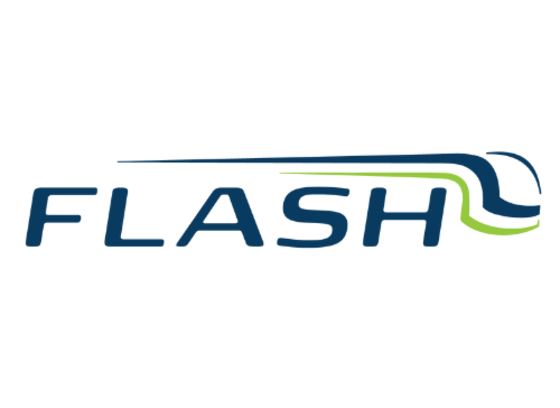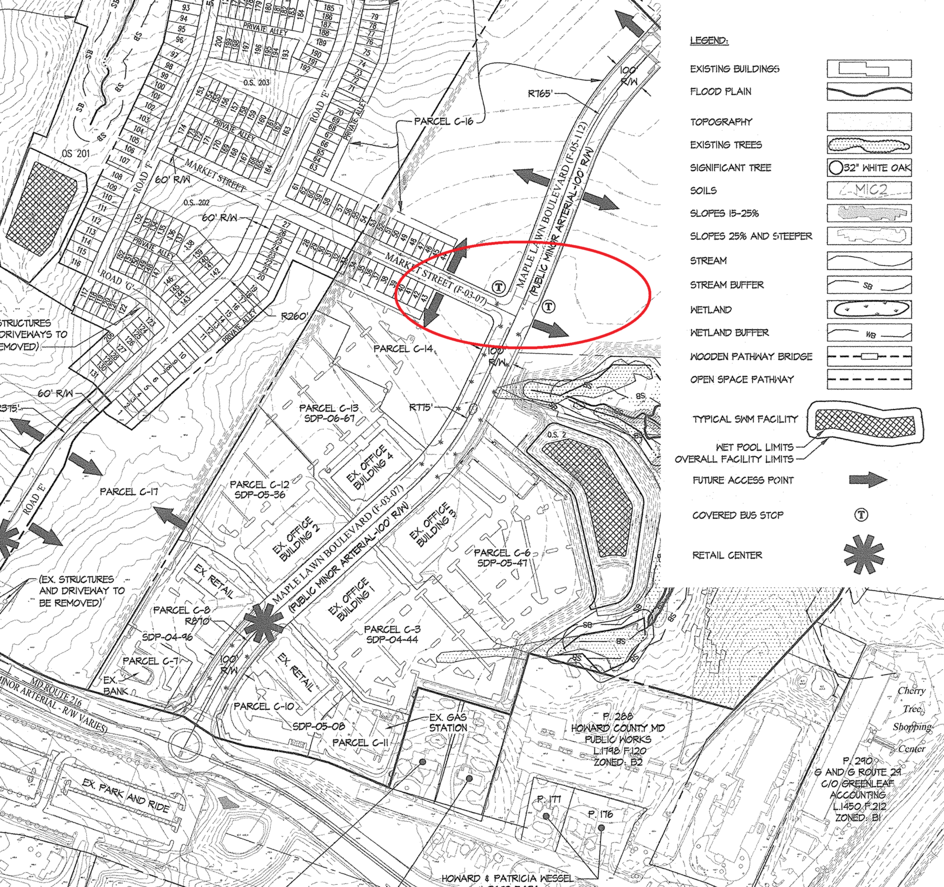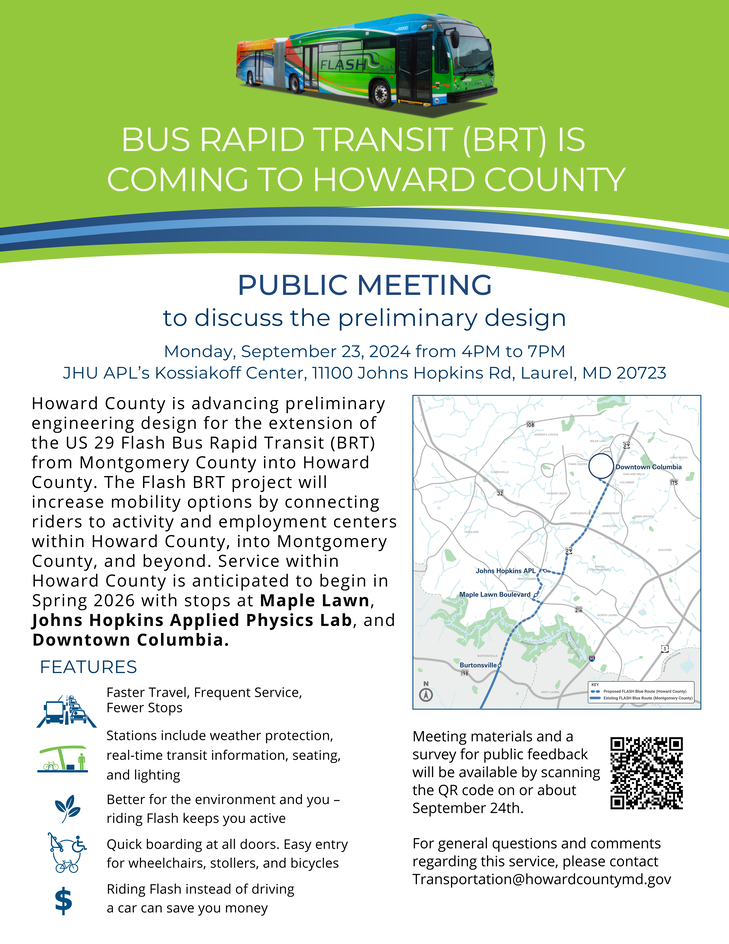Bus Rapid Transit (BRT) in Howard County
Howard County has been planning and evaluating the implementation of a Bus Rapid Transit system for over a decade. The implementation of such a system would represent a significant investment for the County and the state of Maryland and should be pursued only where frequent bus service could be supported. In order to ensure that the BRT project is successful, it has to be supported by strong forecasted ridership and potential shifts from private auto mode shares.
The next step for developing a BRT system in Howard County is extending Montgomery County’s Flash service along the US 29 corridor.
Have a common question about the project?
Full planning and implementation information is below, but a list of FAQs and their answers can be found at the following link.

Planning and Service Development Timeline

Development Plans

Based on principles of “smart growth,” emulating the traditional development found in early 20th century America, the master-planned Maple Lawn community was developed in Fulton by locating shopping/retail, work, and other amenities all within walking distance. Strategically located between Baltimore and Washington, DC, the development has grown to be a regional draw encompassing over 600 acres and 1,340 homes planned. Multiple transit stops were designated in the original development plans.
As a condition of its development, Maple Lawn is also required to develop Transportation Demand Management practices for use in both the residential and commercial areas of the community.
The Plan proposes a vision for Downtown Columbia stating:
To enhance multi-modal connectivity through a variety of safe, convenient, and innovative transportation alternatives.
The development recommended by this Plan and the anticipated private investment in Downtown Columbia would provide a strong incentive to the State and County to improve existing regional bus transit service and to implement new services due to the following:
- Mixed uses (providing strong passenger demand throughout the day in both directions)
- Higher intensity (providing many more people – employees and residents – within walking distance)
- Integrated local transit
- A relocated and enhanced transit center
Similar to Maple Lawn, per the Downtown Columbia Plan, this area is also required to develop Transportation Demand Management practices.
Master Plans
PlanHoward 2030 was Howard County's general plan adopted in 2012. This plan charted a new path for growth and development in the County to sustain the high quality of life residents are accustomed to.
Key initiatives on transportation in the plan included the following:
Transit, bicycle, and pedestrian transportation receive greater emphasis, while also providing for the existing roadway network to be improved. Goals for strategies are proposed for enhancing the existing transit system via new service and increased regional cooperation, and for reducing personal vehicle miles traveled to improve air quality.
Implementing actions for the plan's transportation policies (Policy 5.7) suggested to study the feasibility of regional Bus Rapid Transit (BRT), as well as enhanced local bus service between major business and residential nodes.
HoCo By Design is Howard County's current general plan, advancing a long-term vision for how the County will develop and grow alongside evolving land use, conservation, economic, environmental, and social conditions over the next 20 years. In the plan's County in Motion chapter, policies, initiatives, and actions are proposed under the guidance to manage and provide a safe, equitable, and fiscally sustainable transportation system for all users that is responsive to changing local, regional, and national transportation trends.
Implementation of Bus Rapid Transit on US 29 is emphasized as a significant transportation investments to support growth & redevelopment in the plan, described using the following language:
US 29 from Ellicott City to Burtonsville via Downtown Columbia and Maple Lawn - extend Montgomery County Flash service to provide direct connection to WMATA Red Line and MTA Purple Line with high-quality BRT service.
Bus Rapid Transit (BRT) Studies and Reports
- BRT Concept Study (2012)
- Phase I Report (2013)
- Phase II Study (2016)
- Preliminary Ridership Forecasting Study (2019)
The Concept Plan study presents preliminary plans and costs for a BRT system along various roads and corridors. These corridors are US 29, Broken Land Parkway, MD 216, MD 32 and Snowden River Parkway.
The Phase I report builds on the Concept Plan study and evaluates the proposed BRT network and determine which routes are most viable given the proposed services and ridership forecasts. Four corridors were studied in this report:
- US 29 between Mount Hebron and Silver Spring
- Broken Land Parkway between Columbia Town Center and Savage MARC Station
- MD 32 between Clarksville and Odenton Town Center
- MD 216 between Scaggsville and Odenton Town Center
The travel demand model was also used to screen measures of effectiveness including travel time, average annual daily traffic (AADT), and person-throughput; to refine alignments and potential stations; and to test specific operational characteristics.
The Phase II study is an extension of the previous Conceptual and Phase I efforts performed to evaluate a Bus Rapid Transit network for the County, including linkages to other activity centers and transit systems in the Baltimore/Washington Region. The purpose of the Phase II study is to provide additional detail and rigor not part of the previous work, and filter/refine alternatives to a level that can be carried forward to the next stage of right of way design, environmental impact and preliminary engineering.
The Phase II effort focuses on a Bus Rapid Transit (BRT) system within three primary corridors (US 29, Broken Land Parkway, and US 1), and examines specific route alignment and stations, ancillary feeder transit services, landside services such as park and rides and pedestrian accessibility, preliminary operating costs, and land use plans to support high quality transit service within and between them. The aim is to identify and evaluate the corridors and feasible alternatives that demonstrate the potential for attracting riders and receiving funding.
The purpose of this study was to develop preliminary ridership forecasts for a service on US 29 between Howard County and Montgomery County based on Montgomery County’s service plan for US 29 transit service.
Forecasted year 2040 ridership results on the Howard County BRT, as modeled, show robust daily BRT boardings under each of the scenarios modeled. The forecasted level of passenger boardings in each scenario provides a sufficient base from which to begin new BRT service in Howard County.
Public Information and Engagement
- Grant Funding and Federal Support (2022)
- Grant Funding and Federal Support (2023)
- 2024 Transportation Open House (January 30, 2024)
- Flash Extension Public Meeting (September 23, 2024)
- Additional Public Events
BRT service in Howard County has been supported by the Maryland's federal representatives and viewed as a regional transportation priority at the federal level.
In 2022, Montgomery County was awarded a $3.35M federal grant for the purchase of buses to extend the Flash BRT service to Maple Lawn and Downtown Columbia.
The funding requests were supported by local businesses and organizations through letters of support.
BRT service in Howard County has continued to be supported by the Maryland's federal representatives and viewed as a regional transportation priority at the federal level.
In 2023, Howard County was awarded a $750K federal grant to support construction of the Flash BRT service stations in Maple Lawn, Johns Hopkins APL, and Downtown Columbia.
The funding requests were again supported by local businesses and organizations through letters of support.
The inaugural Howard County Transportation Open House was held Tuesday, January 30, 2024 from 4:30-7:30PM at the Kenneth S. Ulman Innovation Hub (f/k/a the Gateway Building) in Columbia and incorporated the Active Transportation and Transportation Priorities Open Houses. Additional topics covered included transportation safety, Complete Streets, transit and regional planning, and roadway maintenance and operations. The Open House also provided the public with an opportunity to comment on the County's overall transportation priorities, approaches to solving common transportation challenges, and specific projects, including the extension of Montgomery County's Bus Rapid Transit service, Flash, from Burtonsville to Downtown Columbia.
The preliminary designs for each of the proposed Flash stations was unveiled to the public to gather initial responses and feedback.

A public meeting to discuss the service was held on Monday, September 23rd from 4-7PM at Johns Hopkins Applied Physics Lab's Kossiakoff Conference Center. While there was no formal presentation, the design plans were available for public viewing, and staff members were on hand to explain the proposed work, answer any questions, and gather public comments. Meeting materials are posted HERE. The feedback survey closed November 2nd, 2024. The project team has reviewed the feedback and responses to the FAQs can be found HERE.
Commuter Incentives & Resources Happy Hour (May 22, 2024)
Working with the Downtown Columbia Partnership (DTCP), Howard County conducted targeted outreach at the Commuter Incentives & Resources Happy Hour held on May 22, 2024 in Downtown Columbia. The event was directed at over 250 office workers in the area to provide them with information about the future Flash service and the benefits of alternatives to their typical commute.
BikeAround Downtown Columbia (June 1, and September 21, 2024)
Working with the Downtown Columbia Partnership (DTCP), Howard County conducted additional public outreach at the Partnership's spring and fall BikeAround Downtown Columbia Block Parties at Color Burst Park. The event is intended to make cycling a bigger part of residents' transportation, fitness, and recreation routine. Attendees were provided with information about the future Flash service and the benefits of alternatives to their typical commute, while making the connection that the Flash service provides greater advantages to those who choose to bike in our region.
Howard County Economic Development Authority (EDA) Business Resource Expo (October 9, 2024)
The was billed as the ultimate one-stop-shop for accessing essential resources and services that can propel businesses forward. Businesses were provided the opportunity to connect with representatives from various county agencies and departments. To highlight alternative ways to get around the County, Office of Transportation was there to answer questions and gather feedback on the future Flash service.
Culinary Walking Tour (October 13, 2024)
In promotion of Walktober, a celebration of our State’s official exercise and a call to action to promote walking for physical activity and improved health for residents of all ages and abilities, the Downtown Columbia Partnership (DTCP) and external partner organizations celebrated with a Culinary Walking Tour of Downtown Columbia. Designed as a safe and fun walking tour of a few Downtown Columbia favorites, it offers participants the opportunity to experience the walkability of the growing Downtown. To highlight alternative ways to get around DTC, Office of Transportation was there to answer questions and gather feedback on the future Flash service.